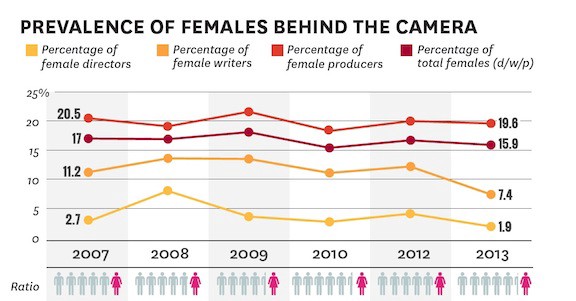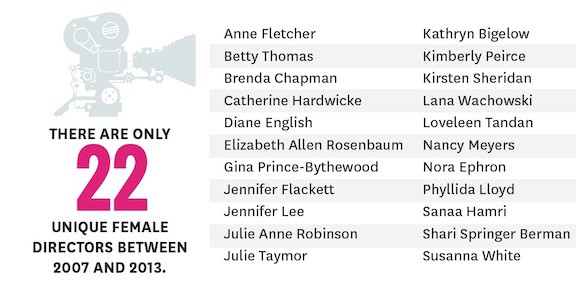
When I started the site nearly seven(!) years ago, research on women onscreen and behind the scenes was sparse. The good news is that, today, studies on this subject arrive regularly from all types of sources.
Dr. Stacy L. Smith, Marc Choueiti, and Dr. Katherine Pieper at USC’s
Media Diversity and Social Change Initiative have added their latest comprehensive research study of the top 100 grossing films over the last six years to the discussion. I love these folks because their research is broad; they look at women working behind the scenes (and those numbers are strikingly small), as well as what’s happening on screen in a variety of categories, including the hypersexualization of girls.
What these numbers remind me is that, no matter how heightened the conversation may be in all quarters about the need to improve gender diversity in films, the numbers are still unbelievably awful for women working in the business. Here’s what Dr. Pieper has to say: “Unfortunately, 2013 hit a 6-year low for female directors and writers in the top 100 domestic films. Our other research reveals that there are real and persistent
impediments facing female directors who want to work at this level. It is time for a frank and serious discussion about strategic interventions that will create real change.”
But there is also some good news. Last year saw a decrease in hypersexuality of girls onscreen: “In 2013, we see a reversal in a three‐year climb in teen hypersexualization. The percentage of female teens depicted in sexy attire or with exposed skin dramatically increased between 2009 and 2012.” Dr. Smith notes, “The findings illuminate that Hollywood can and does change. The reversal of the sexualization trend among female teens should be celebrated by activists at the Geena Davis Institute, Miss Representation, and SPARK.”
Here are some of the findings:
Onscreen in 2013 (of the 100 top-grossing films)
- Across 4,506
speaking characters, 29.2% were female and 70.8% were male. - Only 28% of the films had
a female lead or co‐lead. - R-rated films had
more women speaking characters. - Comedy has the
largest amount of female characters; action has the least. - Only 16% of movies featured gender parity.
- One film contained
no female speaking characters. - Only 2% of films
featured more female than male characters.
Behind the scenes in 2013 (of the 100 top-grossing films)
- Out of 1,374
directors, writers, and producers credited, only 15.9% were women. - There were 5.3 male
filmmakers to every 1 female filmmaker. - Only 1.9% of
directors were women. The number of female directors and writers is at a six‐year low. - Only 7.4% of writers were women.
- Only 19.6% of producers
were women.
Onscreen for the years 2009–2013
- Most women onscreen are between 21‐39 years
old. Men are more likely to be
older, i.e., 40–64 years of age. - 42.9% of children from 0‐12-years-old on screen were female.
- 41.2 of teen characters were female.
- Less than a quarter of all
female roles were for characters between the ages of 40 and 64. - Females (30.2%) were far more likely
than males (9.7%) to be shown in sexualized attire. - Females (29.5%) were more likely
than males to be shown with partial or full nudity (11.7%). - Females were more likely than males to be referenced as physically attractive (13.2% vs.
2.4%).







